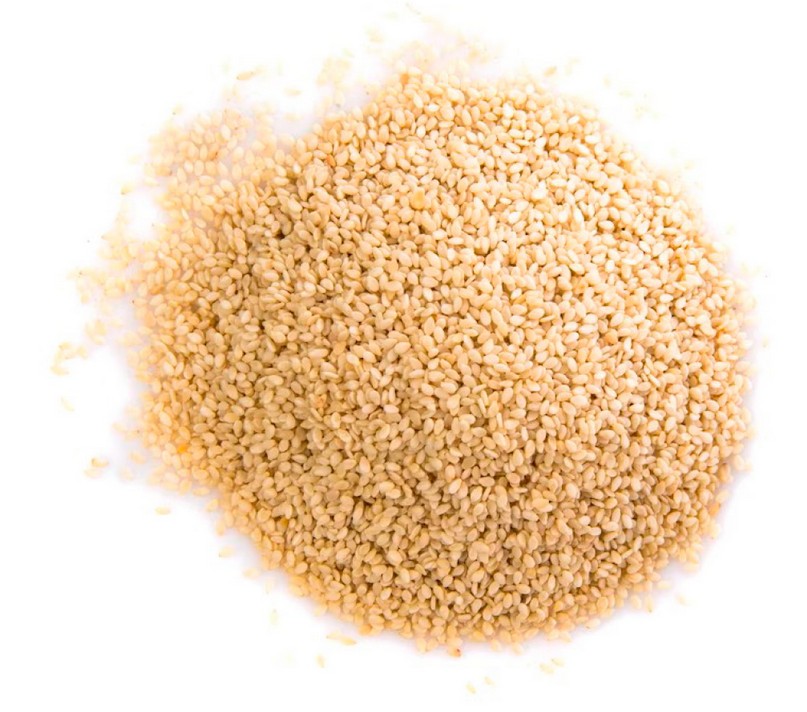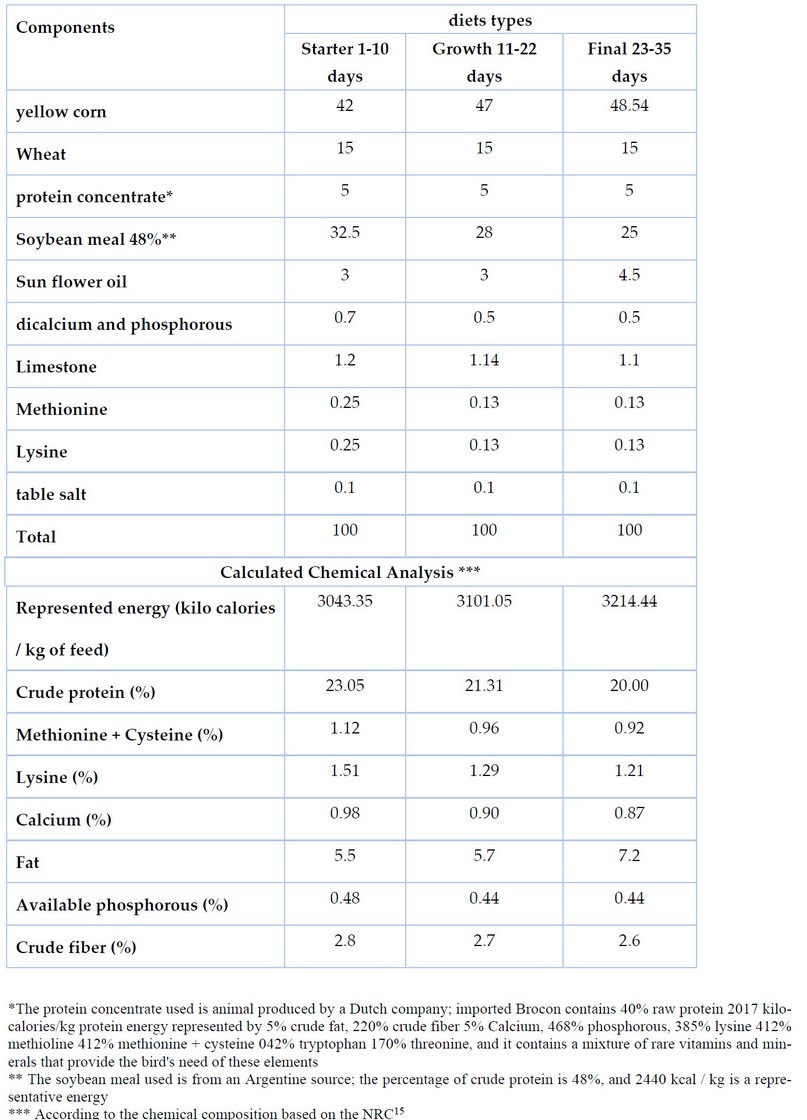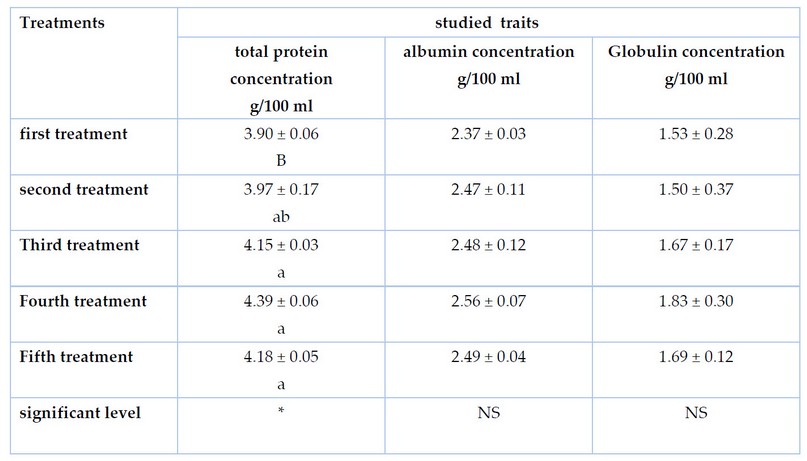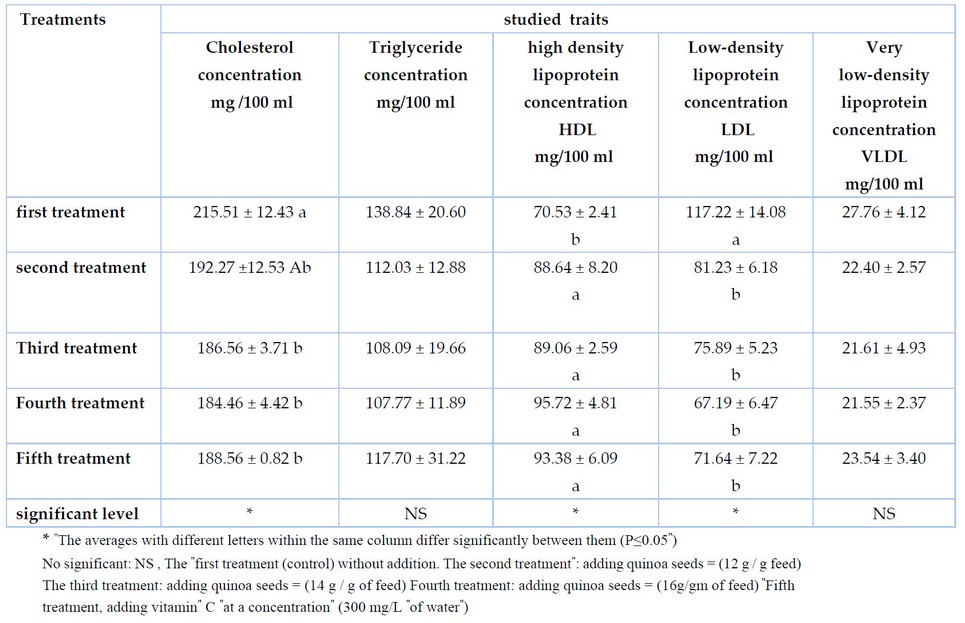2023.08.02.29
Files > Volume 8 > Vol 8 No 2 2023
Comparative study of the effect of adding different levels of Chenopodium quinoa seed powder to the diet and vitamin C to drinking water on some biochemical traits of blood serum to broilers Ross 308
1 Department of Animal Production, College of Agriculture, Al-Qasim Green University, Iraq
2 Department of Animal Production, College of Agriculture, Al-Qasim Green University, Iraq
* Corresponding: [email protected].
Available from: http://dx.doi.org/10.29131/RB/2023.08.02.29
ABSTRACT
This experiment was conducted in the poultry" field "of the" Department of "Animal Production, College of Agriculture, Al-Qasim Green University for" the period "1/10"/2021 until 4/11/2021. The study aimed to add different levels of Chenopodium quinoa seed "powder to the diet and" vitamin C "to" the "drinking water" to know "the" best levels of quinoa seed powder to the diet that can be used in poultry diets. "In the experiment, 225 unsexed broiler chicks (Ross 308") were used, distributed randomly to 15 (cages) with 5 experimental treatments for "each treatment" of "45 birds, and each treatment" included "three replicates" for "each replicate of 15 birds. The "experimental treatments were as follows: The first treatment: control treatment" (basic diet "free of" any addition, whether in feed or drinking water). The second treatment: add 12 g of quinoa seeds/kg of feed; the third treatment: add 14 g of quinoa seeds/kg of feed; the fourth treatment: add 16 g of quinoa seeds/kg of feed; the fifth treatment: add 300 mg of vitamin C/liter of drinking water. The results of the experiment showed a significantly excelled (P≤0.05) for the "third, fourth, and fifth treatments" in total protein "concentration compared to the first treatment" (control). As for "the concentration of" albumin and globulin, no significant differences were recorded among all treatments. "As for the concentration of" cholesterol and low-"density lipoproteins, the second, third," fourth, and fifth "treatments" showed "a significant decrease (P≤0.05") compared to "the" first treatment (control) "and a significant increase (P≤0.05) in the concentration" of high-density lipoproteins
Keywords: Chenopodium quinoa seed, vitamin C, biochemical traits, broilers Ross 308
INTRODUCTION
One of the most critical challenges facing the poultry industry is the search for natural additives to water and feed to improve the productive efficiency of poultry, especially when the European Union in 2006 banned the use of antibiotics that stimulate the growth of the diseases afflict him1.
This led researchers to produce derivatives of some plants and use them in treatments. In contrast, others turned to use medicinal plants because they contain natural chemicals that have proven their ability to improve productivity and physiological and immune traits in broilers, such as lemongrass leaves2 and Bay leaves3, as well as many medicinal plants that were used as growth stimulants in animal diets4.
So, the seeds of Chenopodium quinoa were selected as one of the medicinal plants for its strong antioxidant activities and nutritional properties as a vital precursor that promotes growth and improves the health status because it contains many effective compounds such as phytoecdysteroids, phytosterols and saponins and phytic acid5 and essential fatty acids such as linoleic oleic and palmitic acid6. As well as containing amino acids such as tyrosine and arginine and mineral elements such as iron, calcium phosphorous and zinc7. In addition to its role in improving the coefficient of digestion8.
Quinoa is a food crop similar to grain and has a higher nutritional value than other grains and is an excellent source of fiber 10% which is much higher than wheat 27%, maize 17% and rice 04%9. Vitamin C, or ascorbic acid, is a water-soluble vitamin with negligible solubility in organic solvents. It is relatively stable in its dry crystalline form In natural conditions, poultry does not need to add it due to the ability of their bodies to form it from glucose sugar, but it was observed that the level of vitamin C decreases in the blood intestines and liver when birds are exposed to stress but it is an antioxidant where vitamin C increases the birds’ resistance to some bacterial and viral diseases and thus reduces the percentage of fatalities10. Research has shown that vitamin C acts as an antioxidant and is involved in many vital processes in the body, especially for broilers.
This may be due to the role of vitamin C in the manufacture and regulation of the secretion of corticosteroid hormones from the adrenal cortex11 and because the synthesis of vitamin C is insufficient in newly hatched chicks. As well as birds bred under stress conditions it was necessary to add it to drinking water to provide the required needs of it to reduce the negative impact of its deficiency in the body12 and because quinoa is an important nutrient and there is no local study on its use in poultry feeding.
This plant was chosen to know the effect of adding it at different levels to the broiler’s diet as a natural antioxidant and comparing it with the synthetic antioxidant Vitamin C on production performance and knowing the best concentration Which we can recommend to poultry breeders
MATERIALS AND METHODS
This study was conducted in the poultry field of the Department of Animal Production College of Agriculture/ Al-Qasim Green University from 1/10/2021 to 4/11/2021. In the experiment, 225 unsexed Ross 308 broiler chicks were used and randomly distributed to 15 cages with 5 experimental treatments for each treatment of 45 birds; each treatment included three replicates for each replicate of 15 birds. The chicks were raised in the nests on a bed of white sawdust with a thickness of 7 cm.
The feed was provided to the birds freely as it was provided as a starter diet from the age of 1-11 days on the growth diet from the age of 12-22 days, and on a final diet from the age of 23-35 days at the end of the experiment as shown in Table 1 where the experiment parameters were as follows:
In the first treatment, the control treatment essential diet is free of any addition, whether in feed or drinking water Second treatment, add 12 g of quinoa seeds/kg of the third feed treatment, add 14 g of quinoa seeds/kg in the fourth feed treatment add 16 grams of quinoa seeds/kg of fifth feed treatment add 300 mg of vitamin C/L of drinking water.
The experiment included studying the following characteristics average live body weight gain, feed consumption, food conversion factor, and mortality rate. The averages of these traits were estimated for each week of the experiment, which amounted to five weeks, Use a Completely Randomized Design CRD to study the effect of different treatments on the studied traits the differences between the means were compared using Duncan's polynomial test13 and the readymade statistical program SAS 14 was used to analyze the data.

Figure 1. The quinoa seeds used in the experiment

Table 1. The percentage of feed materials included in the composition of the starter growth and final diet used in the experiment with the calculated chemical composition
RESULTS
Table 2 shows the effect of adding different levels of quinoa seeds to the diet and vitamin C to drinking water on the biochemical traits of the blood serum of broilers at 35 days of age. Where the results of the analysis concerning the concentration of total protein (g/100 ml) showed a significant improvement (P≤0.05) for the birds of the third, fourth and fifth treatments, which recorded the highest concentration of total protein, while the first treatment" (control) "recorded the lowest concentration of total protein."
However, the second treatment did not record any significant differences between it and the other treatments, where there are no significant differences between all treatments for albumin concentration (gm/100ml) and globulin concentration (gm/100ml), we notice.

Table 2. "Effect of adding different levels of" quinoa seeds" to" the diet "and" vitamin C "to drinking water on the" biochemical traits "of" serum "of" broilers "at 35 days of" age ("arithmetic mean ± standard error")
Table 3 shows the effect of adding different levels of" quinoa seeds "to the" diet "and" vitamin C "to drinking water in the serum lipid profile of broilers at" 35 days of "age, where the first treatment (control) recorded the highest" cholesterol "concentration" and reached 215.51 mg / 100 ml, while the treatments recorded.
The third, fourth and fifth lowest cholesterol concentrations, "As for the second treatment, no significant" difference was recorded "between" it "and the" rest of "the" treatments. We also note that there are no significant differences in the concentration of triglycerides (mg / 100 ml) among all the treatments of the experiment.
From the same table, the birds "of the" second, "third). fourth, and fifth" treatments recorded a significant (P≤0.05) superiority (P≤0.05) "over the birds of the first treatment (control) in the trait "of high-density" lipoproteins ("HDL).
While the first treatment recorded the" highest "concentration of" LDL, "with a significant difference (P≤0.05") compared to "the" (second, "third, fourth and fifth") addition treatments, "which recorded the lowest" concentration "of" LDL, which "recorded the lowest concentration of" LDL. As for the" "very low-density lipoproteins" (VLDL), "the results of the" statistical analysis indicate "that there" are no "significant differences between" all "the" experimental "treatments" "at the age of 35 days.

Table 3. Effect of adding different levels of" quinoa seeds "to the diet" and vitamin C "to drinking water" as lipids for serum of broilers "at 35 days of" age ("arithmetic mean ± standard error")
DISCUSSION
The significant improvement of the treatments of quinoa seeds (third and fourth) in total protein concentration compared to the first treatment (control) may be because they contain some biologically active compounds such as saponins and glycosides by increasing the secretion of digestive enzymes, improving the immune response, and protecting gut tissue16. In addition to the high protein content of quinoa seeds by 23%, it became an essential source of protein and used as a partial substitute for protein in broiler diets17.
Thus, this leads "to an increase in the concentration of total protein", as the high concentration of total protein in the blood serum is a good indicator of the bird's good health. The quinoa plant "plays an important role in the" health status "of the" organism "by" containing many active compounds and many minerals in addition to vitamins and fatty acids and a high percentage of amino acids18. As for the significant improvement of vitamin C treatment (the fifth treatment) in the concentration of total protein, it may be due to The role "of vitamin C" in reducing "the secretion of corticosterone" is through inhibiting "the" two enzymes - 21 hydroxylase and 11-penta-hydroxylase, which dominate the synthesis of this hormone from the adrenal cortex19 which leads to a decrease in the effectiveness of protein catabolism to benefit from sugar and then maintaining High level of protein in blood plasma20. The reason for the" reduction in the "concentration of cholesterol and low-density lipoproteins and" the rise of "high-density lipoproteins in" quinoa seed addition "treatments compared to the first treatment (control) may be due to the" quinoa seeds containing many active chemical substances and compounds such as volatile oils, saponins, tannins, glycosides and phenols, which are in its insoluble form, it forms a complex with cholesterol, which prevents its absorption by the intestines, thus lowering the level of cholesterol and low-density lipoproteins21,22 another explanation for the low cholesterol level is due to the role of quinoa seeds in reducing cholesterol synthesis by decreasing the activity of the enzyme HMG-CoA reductase, which has an important role in the cholesterol formation pathway23. Also, the high level of HDL includes inhibiting the oxidation of low-density protein. It thus protects the endothelial cells from the toxic effect of the oxidation of low-density lipoprotein 24, 25.
CONCLUSION
Quinoa seeds significantly improved total protein concentration in the study treatment, making it an important protein source and used as a partial substitute for protein in broiler diets. Similarly, vitamin C's role in resisting stress is controlling the secretion of corticosterone, which is secreted by the adrenal cortex. As vitamin C has an essential role in synthesizing corticosterone hormone, this hormone works to increase glucose utilization by breaking it down. Protein to produce energy. In contrast, there were no significant differences were recorded among all treatments in the concentration of" albumin and globulin,
REFERENCES
1. Fugh-Berman, A. Clinical trials of herbs. Complementary and Alternative therapies in primary care. 1997. 24: 889-908.
2. Al-Awadi, D. H. Yasir and Al- Nadawi, N. A. Ali . “Effect of adding different levels of lemon grass leaves (Cymbopogon citratus) to the diet or its extract into drinking water on some blood parameters for broiler chickens (Ross 308). “ Journal of Physics: Conference Series. 1st International Virtual Conference on Pure Science. 2020. 1-8.
3. Ali, N. A. and Al-Shuhaib M. B. S. Highly effective dietary inclusion of laurel (Laurus nobilis) leaves on productive traits of broiler chicken. Acta Scientiarum. Animal Sciences. 2021. (43): 1-6.
4. Sarinivasan, K. Spices as influencers of body metabolism: An overview of three decades of research. Food Res. Int. 2005.38:77-86.
5. Al-Anbari, I. H. and Sudad K. Al-Taweel. "Nutritional values, medicinal and phytochemical profiling of white Quinoa (Chenopodium quinoa Willd.) Seeds and leaves planted in Iraq." Fayoum J. Agric. Res, & Dev. 2019. 33 (1):179 – 191.
6. Altuna, JL; Silvam M.; Álvarz M.; Quinteros M.F; Morales D. and Carrillo W. "Ecuadorian quinoa (Chenopodium quinoa willd) fatty acids profile" Asian J. Pharm Clin. Res. 2018. 11(11): 1-3.
7. Safiullah P.; Frieda E.; Babu V.; Kamalendu P.; Grato N. and Kerry C. "Nutritional Composition of the Green Leaves of Quinoa (Chenopodium quinoa Willd)" Journal of Food Research. 2019. 8(6): 55-65.
8. Silva José Antonio da; Dávia Guimarães Pompeu; Olavo Flores da Costa; Daniel Bonoto Gonçalves; Carlos Roberto Spehar; Sérgio Marangoni and Paulo Afonso Granjeiro. "The importance of heat against antinutritional factors from Chenopodium quinoa seeds." Food Sci. Technol, Campinas, 2015. 35(1): 74-82.
9. Muhammad A. A.; Mahmoud A.; Muhammad S.; Muhammad U. and Mohamed E. A. Importance of Quinoa (Chenopodium Quinoa) in Poultry Nutrition. In book: Natural Feed Additives Used in the Poultry Industry Edition: 2021. Chapter: 6.
10. Sokolowicz, Z.; E. Herbut and M. Pietras. “Effect of the heat stress onthyroid and adrenal gland functions of broiler chicks, “Anim. Prod. Rev., 1993. 8(suppl.), p. 31.
11. Jaffar, G.H., and Blaha, J. “Effect of ascorbic acid supplementation in drinking water on growth rate, feed efficiency of broiler chickens maintained under acute heat stress conditions.,” Zivocisna – vyroba – UZPI. 1996. 41(11): 485.
12. M. Ajeel, A.; A. Mehdi, L. . Effect Of Eruca Sativa Seeds Powder As Feed Supplementation On Some Physiological Traits Of Male Lambs. Journal of Life Science and Applied Research. 2020, 1, 20-30..
13. Duncan, D.B . Multiple range multiple F-test-Biometeics. 1955. 11:1 – 42.
14. SAS. Statistical Analysis System, User's Guide. Statistical. Version 9.1th ed. SAS. Inst. Inc. Cary. 2012. NC USA .
15. NRC National Research council . Nutrient Requirement of Poultry. (9th rev. ed.). National Research Council. Nat. Academy Press, Washington, 1994. DS, USA.
16. Zeyneb, H.; Pei, H.; Cao, X.; Wang, Y.; Win, Y., and Gong, L. In vitro study of the effect of quinoa and quinoa polysaccharides on human gut microbiota. Food Science & Nutrition, 2021. 00, 1–11.
17. Mustafa S.; Zainab T.; Ayesha R.; Muhammad S.; Muhammad A.; MadihaI.; Sadaf N.; Anwar l. and Zahida S. Laboratory scale study on the effect of feeding quinoa (Chenopodium quinoa) as meal on serum biochemistry of broiler. Pure Appl. Biol., 2019. 8(4): 2326- 2332.
18. Farhan, S. M., Abdulateef, S. M. Al-Enzy, A. F. M, Mohammed, Th. T., Saeid, Z. J. M., Al-Khalani, F. M. H. & Abdulateef, F. M. Effect of heat stress on blood alkalinity of broiler chicks and its reflection in improving the productive performance. Indian Journal of Ecology. 2020, 47: 107-109.
19. Pardue, S. L. Relationship of ascorbic acid to physiological stress in the domestic fowl ph.D.dissertation, Thesis North Caroline State University. Raleigh, NC World. Poultry Science, 1983. 107-123.
20. Coles, E. H. Veterinary clinical pathology. 4th ed. W.B. Saunders. Philadelphia, London, 1986. Hong Kong.
21. Rao, Α.V. and Gurfinkel, D.M. The Bioactivity of Saponins: Triterpenoid and Steroidal Glycosides. Drug Metabolism and Drug Interactions. 2000. 17(1-4):211-35.
22. Nickel, J. L. P.; Spanier, F. T.; Botlho, M.; Arocha Gularte and E. Helbig. Effect of different types of processing on the total phenolic compound content, antioxidant capacity, and saponin content of Chenopodium quinoa Willd grains. Food chemistry. 2016. 139-143
23. Takao T.; Nakamichi W.; Kana Y.; Syoko I.; Saori.; Yukari T.; Kenichi N. and Yotaro K. Hypocholesterolemic Effect of Protein Isolated from Quinoa (Chenopodium quinoa Willd.) Seeds. Food Sci. Technol. Res., 2005. 11 (2): 161 – 167.
24. Navarro-Perez D.; Radcliffe J.; Tierney A. and Jois M. Quinoa Seed Lowers Serum Triglycerides in Overweight and Obese Subjects: A Dose-Response Randomized Controlled Clinical Trial. Curr Dev Nutr. 2017. 1(9): 1-9.
25. Farhan, S. M., Abdulateef, S. M. Al-Enzy, A. F. M, Mohammed, Th. T., Saeid, Z. J. M., Al-Khalani, F. M. H. & Abdulateef, F. M. Effect of heat stress on blood alkalinity of broiler chicks and its reflection in improving the productive performance. Indian Journal of Ecology, 2020. 47: 107-109
Received: 10 February 2023/ Accepted: 15 May 2023 / Published:15 June 2023
Citation: Abdulhadi, E.N; Ali, N A.Comparative study of the effect of adding different levels of Chenopodium quinoa seed powder to the diet and vitamin C to drinking water on some biochemical traits of blood serum to broilers Ross 308. Revis Bionatura 2023;8 (2) 29. http://dx.doi.org/10.21931/RB/2023.08.02.29
